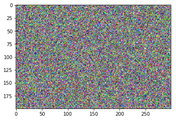numpy get started
导入numpy库, 并查看版本
import numpy as np
np.__version__
'1.14.3'
# pyplot显示画图, 数据分析与可视化
import matplotlib.pyplot as plt
lena = plt.imread('lena.jpg')
# type(lena)
lena
array([[[225, 138, 128],
[224, 137, 127],
[223, 136, 126],
...,
[234, 146, 126],
[220, 129, 110],
[197, 104, 86]],
[[222, 138, 127],
[224, 137, 127],
[224, 137, 127],
...,
[235, 150, 130],
[218, 131, 112],
[189, 102, 83]],
[[222, 138, 127],
[224, 137, 127],
[225, 138, 128],
...,
[230, 148, 127],
[215, 133, 112],
[190, 105, 85]],
...,
[[ 82, 21, 55],
[ 81, 20, 54],
[ 92, 28, 62],
...,
[175, 71, 82],
[175, 68, 78],
[175, 65, 74]],
[[ 80, 18, 55],
[ 81, 20, 54],
[ 94, 33, 67],
...,
[177, 69, 82],
[182, 70, 82],
[183, 72, 81]],
[[ 81, 19, 56],
[ 83, 21, 58],
[ 96, 35, 69],
...,
[178, 68, 81],
[183, 71, 83],
[188, 74, 84]]], dtype=uint8)
lena2 = lena - 10
plt.imshow(lena2)
plt.show()

创建ndarray
使用np.array()由python list创建
- numpy默认ndarray的所有元素的类型是相同的
- 如果传递的列表中包含不同的类型, 则统一为同一类型, 优先级:str > float > int
n1 = np.array([3, 1, 4, 5])
n1
array([3, 1, 4, 5])
n2 = np.array([[2, 3, 4, 5], [4, 6, 1, 9], [5, 6, 7, 8]])
n2
array([[2, 3, 4, 5],
[4, 6, 1, 9],
[5, 6, 7, 8]])
type(n2)
# shape是属性,不是方法
n2.shape
(3, 4)
n1.shape
(4,)
# 行, 列, 维度
# 一张二维图片转化成数组为三位数组
lena.shape
(512, 512, 3)
n3 = np.array(['ABC', 1, 3.14])
n3
array(['ABC', '1', '3.14'], dtype='<U4')
使用np.routines函数创建
np.ones(shape=(10, 8), dtype=int)
array([[1, 1, 1, 1, 1, 1, 1, 1],
[1, 1, 1, 1, 1, 1, 1, 1],
[1, 1, 1, 1, 1, 1, 1, 1],
[1, 1, 1, 1, 1, 1, 1, 1],
[1, 1, 1, 1, 1, 1, 1, 1],
[1, 1, 1, 1, 1, 1, 1, 1],
[1, 1, 1, 1, 1, 1, 1, 1],
[1, 1, 1, 1, 1, 1, 1, 1],
[1, 1, 1, 1, 1, 1, 1, 1],
[1, 1, 1, 1, 1, 1, 1, 1]])
ones = np.ones(shape=(100, 80, 3), dtype=float)
plt.imshow(ones)
plt.show()

np.zeros((4, 4))
array([[0., 0., 0., 0.],
[0., 0., 0., 0.],
[0., 0., 0., 0.],
[0., 0., 0., 0.]])
np.full((10, 10), fill_value=1024)
array([[1024, 1024, 1024, 1024, 1024, 1024, 1024, 1024, 1024, 1024],
[1024, 1024, 1024, 1024, 1024, 1024, 1024, 1024, 1024, 1024],
[1024, 1024, 1024, 1024, 1024, 1024, 1024, 1024, 1024, 1024],
[1024, 1024, 1024, 1024, 1024, 1024, 1024, 1024, 1024, 1024],
[1024, 1024, 1024, 1024, 1024, 1024, 1024, 1024, 1024, 1024],
[1024, 1024, 1024, 1024, 1024, 1024, 1024, 1024, 1024, 1024],
[1024, 1024, 1024, 1024, 1024, 1024, 1024, 1024, 1024, 1024],
[1024, 1024, 1024, 1024, 1024, 1024, 1024, 1024, 1024, 1024],
[1024, 1024, 1024, 1024, 1024, 1024, 1024, 1024, 1024, 1024],
[1024, 1024, 1024, 1024, 1024, 1024, 1024, 1024, 1024, 1024]])
# np.eye(N, M=None, k=0, dtype=<class 'float'>, order='C')
# 对角线为1, 其他位置为0, 满秩矩阵
np.eye(10)
array([[1., 0., 0., 0., 0., 0., 0., 0., 0., 0.],
[0., 1., 0., 0., 0., 0., 0., 0., 0., 0.],
[0., 0., 1., 0., 0., 0., 0., 0., 0., 0.],
[0., 0., 0., 1., 0., 0., 0., 0., 0., 0.],
[0., 0., 0., 0., 1., 0., 0., 0., 0., 0.],
[0., 0., 0., 0., 0., 1., 0., 0., 0., 0.],
[0., 0., 0., 0., 0., 0., 1., 0., 0., 0.],
[0., 0., 0., 0., 0., 0., 0., 1., 0., 0.],
[0., 0., 0., 0., 0., 0., 0., 0., 1., 0.],
[0., 0., 0., 0., 0., 0., 0., 0., 0., 1.]])
# np.linspace(start, stop, num=50, endpoint=True, retstep=False, dtype=None)
np.linspace(0, 100, 20)
array([ 0. , 5.26315789, 10.52631579, 15.78947368,
21.05263158, 26.31578947, 31.57894737, 36.84210526,
42.10526316, 47.36842105, 52.63157895, 57.89473684,
63.15789474, 68.42105263, 73.68421053, 78.94736842,
84.21052632, 89.47368421, 94.73684211, 100. ])
# np.arange([start,] stop[, step,], dtype=None)
# 左闭右开
np.arange(0, 100, 5)
array([ 0, 5, 10, 15, 20, 25, 30, 35, 40, 45, 50, 55, 60, 65, 70, 75, 80,
85, 90, 95])
# np.random.randint(low, high=None, size=None, dtype='l')
np.random.randint(0, 150, 5)
array([127, 110, 56, 63, 77])
# np.random.randn(d0, d1, ..., dn)
# 标准正态分布
np.random.randn(100)
array([-0.41595026, 1.47042723, 0.03288821, 0.85004019, 0.7950821 ,
0.13841712, 0.28218393, 1.22280226, -0.55662926, -0.85044176,
0.87454005, -1.56832096, 1.69536713, 0.12126746, 1.05180469,
0.78131875, -0.70417438, -0.58430437, -0.49943889, 0.2231934 ,
-0.55686039, -0.48619634, 0.48127741, 0.27138361, 0.17976988,
-0.11101901, -0.71860609, 1.2858034 , 0.26501713, 0.15528386,
-0.3639874 , -0.50213498, -1.3080041 , -2.35717083, -0.648195 ,
0.24412035, -1.50979317, 1.09656183, 0.00946873, -0.73389828,
-0.04357452, 0.80743789, -1.72143062, 0.10460993, 1.32929205,
0.06736016, -1.56802382, 0.90329101, -0.45505224, 0.04915999,
0.26430304, -0.40411427, 0.42802756, -1.69807546, 0.27891151,
1.05498128, 0.94090423, -0.42022151, 1.65546614, -0.22287079,
0.69203073, 0.96486237, -1.28087795, 0.75158138, -0.18673762,
-0.70781096, -1.71156378, 0.65202125, -0.3525935 , 0.4323014 ,
-0.63716862, -0.67085324, -0.30546365, 0.39392657, -2.13986037,
-0.0085726 , -1.67360167, 1.84832111, 0.0671747 , 0.01600444,
0.52551343, -0.60296408, -0.47100002, -2.18264449, 0.46744126,
0.72398992, -1.71408793, 0.14587077, -0.18404951, -0.80683105,
1.73309297, 0.35799329, 0.73527189, 0.13199485, 0.26461892,
0.54344243, 0.49003007, 0.21602823, -1.22451068, -0.21714807])
# np.random.normal(loc=0.0, scale=1.0, size=None)
# scale波动
np.random.normal(loc=175, scale=1, size=100)
array([176.21310971, 172.20006366, 175.29247008, 173.66475082,
173.68890116, 174.71321419, 175.80304124, 175.10018316,
173.44016299, 174.80136342, 175.37660695, 177.19022468,
176.32440094, 173.14755284, 175.06826748, 176.42310704,
174.76973001, 172.07888002, 174.81805161, 175.85111712,
176.1612796 , 175.9304326 , 174.08051939, 174.2482614 ,
172.47992484, 174.73893155, 173.8072 , 173.57799107,
173.78284387, 176.32936172, 175.17084547, 173.21273207,
175.28091245, 174.47728685, 174.24929528, 174.37795464,
173.35172255, 175.33469387, 174.38263904, 176.28884503,
174.48028776, 176.07224738, 175.28880278, 177.13037103,
171.68068476, 174.58779908, 177.3445544 , 174.96102577,
173.9927033 , 174.81596921, 173.40709395, 175.09461029,
174.56116781, 176.10069031, 177.34382616, 176.63857035,
175.29170695, 173.77097116, 173.92263266, 177.1159495 ,
175.33183934, 175.41897696, 174.01483045, 175.26064743,
174.52707392, 174.71789507, 175.83135718, 175.3980088 ,
175.28031481, 176.63722956, 176.14911054, 174.1617964 ,
174.12355257, 175.97611042, 175.4970436 , 176.42210635,
173.54120183, 174.25305399, 172.89636185, 175.76694058,
172.44363816, 172.97763963, 173.76208303, 175.68367144,
174.39331671, 174.26906247, 173.97178951, 174.34262788,
174.78171771, 176.3154983 , 175.18898772, 175.03515302,
175.01803086, 175.89679058, 174.81759265, 174.66847045,
175.67714752, 173.83397302, 172.11278424, 174.91772609])
# 生成0到1的随机数, 左闭右开
# 使用随机数生成一张图片
r = np.random.random(size=(200, 300, 3))
plt.imshow(r)
plt.show()

ndarray的属性
4个必记参数: ndim: 维度
shape: 形状(各维度的长度)
size: 总长度
dtype: 元素类型
ndarray的基本操作
索引
# 二维数组索引
n5 = np.random.randint(0, 100, (3, 4))
n5
array([[44, 50, 39, 56],
[29, 50, 49, 95],
[11, 20, 97, 73]])
n5[0, 1]
50
# 三位数组索引
n6 = np.random.randint(0, 100, (3, 4, 5))
n6
array([[[83, 35, 84, 88, 18],
[62, 37, 55, 65, 8],
[26, 86, 50, 11, 37],
[37, 93, 1, 86, 71]],
[[33, 25, 72, 13, 82],
[80, 36, 69, 37, 32],
[43, 79, 40, 3, 46],
[67, 10, 79, 98, 58]],
[[44, 36, 89, 64, 86],
[82, 9, 37, 33, 13],
[59, 55, 45, 59, 29],
[72, 68, 88, 23, 64]]])
# 可以看成一维和二维组合
n6[0, 3, 1]
93
切片
n7 = np.random.randint(150, size=10)
n7
array([ 12, 144, 141, 103, 82, 119, 85, 83, 36, 45])
# 和python list一样 左闭右开
# 一维数组切片
n7[0:5]
array([ 12, 144, 141, 103, 82])
n6.shape
(3, 4, 5)
n6
array([[[83, 35, 84, 88, 18],
[62, 37, 55, 65, 8],
[26, 86, 50, 11, 37],
[37, 93, 1, 86, 71]],
[[33, 25, 72, 13, 82],
[80, 36, 69, 37, 32],
[43, 79, 40, 3, 46],
[67, 10, 79, 98, 58]],
[[44, 36, 89, 64, 86],
[82, 9, 37, 33, 13],
[59, 55, 45, 59, 29],
[72, 68, 88, 23, 64]]])
# 三位数组切片
n6[0:2]
array([[[83, 35, 84, 88, 18],
[62, 37, 55, 65, 8],
[26, 86, 50, 11, 37],
[37, 93, 1, 86, 71]],
[[33, 25, 72, 13, 82],
[80, 36, 69, 37, 32],
[43, 79, 40, 3, 46],
[67, 10, 79, 98, 58]]])
n6[0:2, 1:3]
array([[[62, 37, 55, 65, 8],
[26, 86, 50, 11, 37]],
[[80, 36, 69, 37, 32],
[43, 79, 40, 3, 46]]])
n6[0:2, 1:3, -2:]
array([[[65, 8],
[11, 37]],
[[37, 32],
[ 3, 46]]])
# 将数据反转
n8 = np.arange(0, 10, 1)
n8
array([0, 1, 2, 3, 4, 5, 6, 7, 8, 9])
n8[::-1]
array([9, 8, 7, 6, 5, 4, 3, 2, 1, 0])
n8[::-2]
array([9, 7, 5, 3, 1])
变形reshape
使用reshape函数, 注意参数是一个tuple
# a.reshape(shape, order='C')
n8.reshape((5, 2))
array([[0, 1],
[2, 3],
[4, 5],
[6, 7],
[8, 9]])
# 对图片进行reshape
lena.reshape(512 * 512 * 3)
array([225, 138, 128, ..., 188, 74, 84], dtype=uint8)
# 如果是负数, 直接转换成一维的数组ndarray
lena.reshape(-1)
array([225, 138, 128, ..., 188, 74, 84], dtype=uint8)
级联
np.concatenate() 级联需要注意的事项:
1. 级联的参数是列表, 一定要加中括号或小括号
2. 维度必须相同
3. 形状相符
4. 级联的方向默认是shape元组的第一个值代表的维度方向
5. 可以通过axis参数改变级联的方向
import numpy as np
n9 = np.random.randint(0, 10, size=(5, 5))
n9
array([[1, 4, 8, 8, 1],
[0, 0, 8, 4, 0],
[3, 1, 2, 3, 5],
[9, 6, 5, 8, 0],
[3, 6, 1, 7, 2]])
# np.concatenate((a1, a2, ...), axis=0, out=None)
np.concatenate((n9, n9))
array([[1, 4, 8, 8, 1],
[0, 0, 8, 4, 0],
[3, 1, 2, 3, 5],
[9, 6, 5, 8, 0],
[3, 6, 1, 7, 2],
[1, 4, 8, 8, 1],
[0, 0, 8, 4, 0],
[3, 1, 2, 3, 5],
[9, 6, 5, 8, 0],
[3, 6, 1, 7, 2]])
n9.ndim
2
np.concatenate((n9, n9), axis=1)
array([[1, 4, 8, 8, 1, 1, 4, 8, 8, 1],
[0, 0, 8, 4, 0, 0, 0, 8, 4, 0],
[3, 1, 2, 3, 5, 3, 1, 2, 3, 5],
[9, 6, 5, 8, 0, 9, 6, 5, 8, 0],
[3, 6, 1, 7, 2, 3, 6, 1, 7, 2]])
import matplotlib.pyplot as plt
lena = plt.imread('lena.jpg')
lenas = np.concatenate((lena, lena))
plt.imshow(lenas)
plt.show()

np.hstack与np.vstack
水平级联与垂直级联, 处理自己, 进行维度的变更
# vertical 垂直
n10 = np.random.randint(150, size=10)
n10
array([138, 122, 78, 145, 95, 114, 98, 49, 137, 147])
n11 = np.vstack(n10)
n11
array([[138],
[122],
[ 78],
[145],
[ 95],
[114],
[ 98],
[ 49],
[137],
[147]])
n12 = np.array([[2, 3, 4, 5, 6]])
# 可以对二维及多位数组进行降维
np.hstack(n12)
array([2, 3, 4, 5, 6])
n13 = np.array([[2, 3, 4, 5, 6], [4, 5, 6, 7, 8]])
np.hstack(n13)
array([2, 3, 4, 5, 6, 4, 5, 6, 7, 8])
np.hstack(np.hstack(lena))
array([225, 138, 128, ..., 188, 74, 84], dtype=uint8)
切分
与级联类似, 三个函数完成切分:
- np.split
- np.vsplit
- np.hsplit
# np.split(ary, indices_or_sections, axis=0)
n14 = np.random.randint(0, 150, size=(5, 7))
n14
array([[ 0, 107, 40, 62, 108, 120, 130],
[ 40, 79, 34, 48, 110, 48, 24],
[ 52, 121, 69, 18, 88, 73, 64],
[147, 41, 118, 138, 128, 69, 76],
[ 67, 30, 77, 87, 10, 18, 69]])
# 第一行切 第三行切
np.split(n14, (1, 3))
[array([[ 0, 107, 40, 62, 108, 120, 130]]),
array([[ 40, 79, 34, 48, 110, 48, 24],
[ 52, 121, 69, 18, 88, 73, 64]]),
array([[147, 41, 118, 138, 128, 69, 76],
[ 67, 30, 77, 87, 10, 18, 69]])]
lena3 = np.split(lena, (200, 350))[1]
plt.imshow(lena3)
plt.show()

# axis=0 默认, 切分行
# axis=1, 切分列
np.split(n14, (1, 3), axis=1)
[array([[ 0],
[ 40],
[ 52],
[147],
[ 67]]), array([[107, 40],
[ 79, 34],
[121, 69],
[ 41, 118],
[ 30, 77]]), array([[ 62, 108, 120, 130],
[ 48, 110, 48, 24],
[ 18, 88, 73, 64],
[138, 128, 69, 76],
[ 87, 10, 18, 69]])]
# 竖直方向切分的是行
np.vsplit(n14, (1, 3))
[array([[ 0, 107, 40, 62, 108, 120, 130]]),
array([[ 40, 79, 34, 48, 110, 48, 24],
[ 52, 121, 69, 18, 88, 73, 64]]),
array([[147, 41, 118, 138, 128, 69, 76],
[ 67, 30, 77, 87, 10, 18, 69]])]
# 水平方向切分的是列
np.hsplit(n14, (2, 3))
[array([[ 0, 107],
[ 40, 79],
[ 52, 121],
[147, 41],
[ 67, 30]]), array([[ 40],
[ 34],
[ 69],
[118],
[ 77]]), array([[ 62, 108, 120, 130],
[ 48, 110, 48, 24],
[ 18, 88, 73, 64],
[138, 128, 69, 76],
[ 87, 10, 18, 69]])]
副本
所有赋值运算不会为ndarray的任何元素创建副本, 对赋值后的对象的操作也对原来的对象生效.
l = [1, 2, 3, 4]
n = np.array(l)
n
array([1, 2, 3, 4])
# 当数据是ndarray时, 如果用=赋值, 内存没有改变
n2 = n
n2[2] = 90
n2
array([ 1, 2, 90, 4])
n
array([ 1, 2, 90, 4])
# copy()函数创建副本
n3 = n.copy()
n3[0] = 80
n3
array([80, 2, 90, 4])
n
array([ 1, 2, 90, 4])
ndarray的聚合操作
求和 np.sum
n15.mean()
87.0625
n15.mean(axis=0)
array([[ 82.75, 85.25, 58.5 , 116. ],
[ 69. , 96.5 , 56. , 115.25],
[ 95.5 , 92.5 , 107.75, 108.5 ],
[ 47.25, 95.5 , 47. , 119.75]])
import numpy as np
import matplotlib.pyplot as plt
n16 = np.random.randint(0, 150, size=(4, 4, 4))
n16
array([[[114, 88, 143, 100],
[ 91, 7, 84, 49],
[114, 54, 14, 20],
[ 83, 12, 135, 1]],
[[ 36, 95, 80, 96],
[ 97, 98, 39, 146],
[ 2, 127, 53, 105],
[ 71, 15, 11, 97]],
[[ 3, 64, 27, 2],
[109, 28, 81, 123],
[ 64, 95, 112, 66],
[ 42, 131, 79, 123]],
[[ 54, 31, 10, 133],
[138, 23, 145, 122],
[ 66, 29, 79, 97],
[119, 139, 12, 100]]])
np.mean(n16, axis=0)
array([[ 51.75, 69.5 , 65. , 82.75],
[108.75, 39. , 87.25, 110. ],
[ 61.5 , 76.25, 64.5 , 72. ],
[ 78.75, 74.25, 59.25, 80.25]])
np.sum(n16, axis=0)
array([[207, 278, 260, 331],
[435, 156, 349, 440],
[246, 305, 258, 288],
[315, 297, 237, 321]])
最大值和最小值 np.max/np.min
display(lena.max(), lena.min())
255
0
display(lena.max(axis=0), lena.min())
array([[240, 155, 139],
[239, 152, 138],
[240, 154, 135],
...,
[244, 211, 177],
[246, 211, 178],
[245, 209, 179]], dtype=uint8)
0
n15 = np.random.randint(0, 150, size=(4, 4, 4))
n15
array([[[ 18, 91, 115, 148],
[141, 145, 58, 148],
[ 80, 97, 70, 82],
[ 48, 47, 85, 108]],
[[ 91, 87, 13, 93],
[ 18, 50, 7, 145],
[124, 74, 124, 105],
[ 7, 124, 29, 130]],
[[146, 77, 76, 98],
[ 34, 126, 34, 96],
[127, 70, 148, 131],
[ 25, 148, 2, 141]],
[[ 76, 86, 30, 125],
[ 83, 65, 125, 72],
[ 51, 129, 89, 116],
[109, 63, 72, 100]]])
n15.max()
148
n15.max(axis=0)
array([[146, 91, 115, 148],
[141, 145, 125, 148],
[127, 129, 148, 131],
[109, 148, 85, 141]])
n15.max(axis=2)
array([[148, 148, 97, 108],
[ 93, 145, 124, 130],
[146, 126, 148, 148],
[125, 125, 129, 109]])
其他聚合操作
np.std: 标准方差
np.power: 幂运算
np.argmin: 最小值的索引
np.argmax: 最大值的索引
np.argwhere: 满足条件的元素的索引
np.sum和np.nansum的区别: nan not a number
n20 = np.random.randint(0, 100, size=10)
n20
array([35, 84, 96, 92, 32, 96, 76, 72, 82, 59])
np.argmin(n20)
4
np.argmax(n20)
2
np.argwhere(n20 > 70)
array([[1],
[2],
[3],
[5],
[6],
[7],
[8]], dtype=int64)
index = np.argwhere(n20 > 70)
n20[index]
array([[84],
[96],
[92],
[96],
[76],
[72],
[82]])
n20[np.array([[0], [1]])]
array([[35],
[84]])
操作文件
使用pandas打开文件.csv 获取文件中的数据
import pandas as pd
df = pd.read_csv('../data/height.csv')
df
| order | name | height | |
|---|---|---|---|
| 0 | 1 | Jay | 175 |
| 1 | 2 | JJ | 175 |
| 2 | 3 | four | 168 |
| 3 | 4 | Neng | 170 |
| 4 | 5 | Xie | 165 |
| 5 | 6 | Feet | 170 |
df.values
array([[1, 'Jay', 175],
[2, 'JJ', 175],
[3, 'four', 168],
[4, 'Neng', 170],
[5, 'Xie', 165],
[6, 'Feet', 170]], dtype=object)
ndarray的矩阵操作
基本矩阵操作
算术运算符
n21 = np.random.randint(0, 10, size=(4, 5))
n21
array([[4, 9, 1, 9, 9],
[7, 7, 3, 7, 3],
[6, 4, 2, 5, 4],
[0, 0, 1, 4, 8]])
n21 + 10
array([[14, 19, 11, 19, 19],
[17, 17, 13, 17, 13],
[16, 14, 12, 15, 14],
[10, 10, 11, 14, 18]])
n22 = n21 / 2
n22
array([[2. , 4.5, 0.5, 4.5, 4.5],
[3.5, 3.5, 1.5, 3.5, 1.5],
[3. , 2. , 1. , 2.5, 2. ],
[0. , 0. , 0.5, 2. , 4. ]])
np.add(n21, n21)
array([[ 8, 18, 2, 18, 18],
[14, 14, 6, 14, 6],
[12, 8, 4, 10, 8],
[ 0, 0, 2, 8, 16]])
矩阵积 np.dot()
n23 = np.random.randint(0, 10, size=(2, 3))
n24 = np.random.randint(0, 10, size=(3, 2))
display(n23, n24)
array([[2, 2, 4],
[8, 7, 8]])
array([[3, 0],
[2, 1],
[3, 0]])
np.dot(n23, n24)
array([[22, 2],
[62, 7]])
广播机制
ndarray广播机制的两条规则:
1. 为缺失的维度补1
2. 嘉定缺失元素用已有值填充
m = np.ones((2, 3))
a = np.arange(3)
display(m, a)
array([[1., 1., 1.],
[1., 1., 1.]])
array([0, 1, 2])
# numpy的广播机制, 维度不对应, 自动补全
m + a
array([[1., 2., 3.],
[1., 2., 3.]])
b = np.arange(3).reshape((3, 1))
b1 = np.arange(3)
display(b, b1)
b + b1
array([[0],
[1],
[2]])
array([0, 1, 2])
array([[0, 1, 2],
[1, 2, 3],
[2, 3, 4]])
b2 = np.ones((4, 1))
b3 = np.arange(4)
display(b2, b3)
array([[1.],
[1.],
[1.],
[1.]])
array([0, 1, 2, 3])
b2 + b3
array([[1., 2., 3., 4.],
[1., 2., 3., 4.],
[1., 2., 3., 4.],
[1., 2., 3., 4.]])
ndarray的排序
n31 = np.array([2, 5, 1, 7, 4])
def sortn(nd):
'''冒泡排序'''
for i in range(nd.size):
for j in range(i, nd.size):
if nd[i] > nd[j]:
nd[i], nd[j] = nd[j], nd[i]
return nd
sortn(n31)
array([1, 2, 4, 5, 7])
# 降低运算的空间复杂度和时间复杂度
def sortnd(nd):
for i in range(nd.size):
# 切片, 索引不对应
min_index = np.argmin(nd[i:]) + i
# print(min_index)
# print(i,nd[i],nd[min_index])
nd[i], nd[min_index] = nd[min_index], nd[i]
return nd
sortnd(n31)
array([1, 2, 4, 5, 7])
快速排序
np.sort()与ndarray.sort()都可以, 但是有区别:
- np.sort()不改变输入
- ndarray.sort()本地处理, 不占用空间, 但改变输入
# a.sort(axis=-1, kind='quicksort', order=None)
n32 = np.random.randint(0, 150, size=10)
n32
array([131, 31, 101, 57, 96, 50, 142, 133, 83, 141])
# 使用ndarray.sort(), 原来的数据进行了改变, 不占内存
n32.sort()
n32
array([ 0, 24, 36, 43, 85, 121, 121, 135, 138, 141])
n33 = np.sort(n32)
display(n32, n33)
array([131, 31, 101, 57, 96, 50, 142, 133, 83, 141])
array([ 31, 50, 57, 83, 96, 101, 131, 133, 141, 142])
部分排序
np.partition(a, k)
- 当k为正时, 得到最小的k个数
- 当k为负时, 得到最大的k个数
nd = np.random.randint(0, 150, size=20)
nd
array([145, 134, 88, 140, 10, 59, 132, 134, 31, 74, 91, 79, 18,
44, 21, 140, 34, 89, 63, 26])
np.partition(nd,-5)
array([ 18, 26, 63, 34, 10, 59, 21, 44, 31, 74, 79, 91, 88,
89, 132, 134, 134, 140, 140, 145])
np.partition(nd,5)
array([ 10, 18, 21, 26, 31, 34, 44, 59, 63, 74, 91, 79, 134,
134, 132, 140, 140, 89, 88, 145])